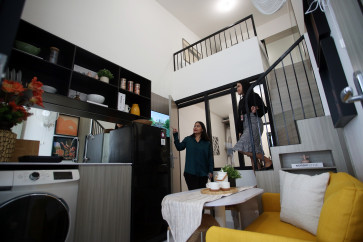Popular Reads
Top Results
Can't find what you're looking for?
View all search resultsPopular Reads
Top Results
Can't find what you're looking for?
View all search resultsRI struggles in vocational education development
Ready for work: Students of the Astra Manufacturing Polytechnic (Polman Astra) mechatronics study program participate in a lesson on electricity installation at the polytechnic’s laboratory in North Jakarta
Change text size
Gift Premium Articles
to Anyone

R
eady for work: Students of the Astra Manufacturing Polytechnic (Polman Astra) mechatronics study program participate in a lesson on electricity installation at the polytechnic’s laboratory in North Jakarta. Polman Astra, which is run by one of the foundations owned by automotive giant Astra, has been appointed by the Education and Culture Ministry to help create a development plan for four-year vocational school (SMK) studies on mechatronics. ((Polman Astra handout))
The government's efforts to develop Indonesia's vocational education system have been meet with a wide range of challenges related to costs, quality of educators and industry appreciation toward vocational diplomas.
Similar issues first arose when President Joko “Jokowi” Widodo issued a 2016 presidential instruction to revive vocational education, said Patdono Suwignjo, director general of science, technology and higher education institutions at the Research, Technology and Higher Education Ministry.
He said it would take a long time for there to be as many polytechnic schools as there were universities across the country. The ministry only sees two or three new applications for polytechnic schools per year, even after it stopped granting new university applications in 2017.
“If we keep at this pace, we’ll need 800 years to add another 2,075 polytechnics to match the number of universities,” he said during his keynote speech at the Indonesia Vocational Education and Training Summit in Jakarta on Wednesday.
Indonesia currently has about 300 polytechnic schools, equal to only 20 percent of all the higher education institutions in the country. The cost of establishing a new polytechnic school in Indonesia was much higher than the cost of opening a university, Patdono added.
“The cost of establishing a new polytechnic can reach up to Rp 400 billion [US$28.24 million], while the cost of establishing a new university is only Rp 30 billion,” said Patdono, adding that the ministry would continue to impose a “moratorium” on new universities until 2024 and only approve applications from new polytechnic schools in partnership with industries.
The ministry is also seeking to partner with foreign companies and governments from countries like Australia, Korea and the Netherlands to improve the quality of Indonesia’s vocational education, according to the ministry’s director of learning, Paristiyanti Nurwardani.
“Through this partnership, we hope we can achieve our target of 500 polytechnics by 2024,” Paristiyanti said, adding that the ministry was also aiming to nearly quadruple the number of polytechnic students from 721,288 to 2.75 million by the same year.
Apart from costs, another issue on the top of the list that hampers vocational education development in Indonesia is the quality of teachers, trainers and assessors, as Indonesia lacks the desired number of postgraduate schools in applied sciences.
Lecturers attending the summit complained about the government’s teaching requirements in vocational education. Fieldwork competency was more important, the lecturers argued, asking the government to provide more lecturer internship opportunities.
To help tackle this problem, the government’s partnership with overseas vocational education institutions would also enable lecturers not only to get a master’s degree but also to get internship opportunities either in Indonesia or abroad, Paristiyanti said.
Politeknik ATMI Surakarta deputy director for cooperation and career centers FX Suryadi said maintaining good relations with alumni also worked to help improve its lecturers’ competence. “Our alumni can provide our lecturers with industry access and help them to better their knowledge so that they can increase their teaching competence,” he added.
Other than costs and educator competency, there is also a lack of appreciation for polytechnic graduates from employers, as evident in the smaller salaries obtained by vocational diploma graduates (D4) compared with those who hold a bachelor’s degree (S1), according to Patdono.
“Companies, including state-owned enterprises [SOEs], often think that D4 graduates are below S1 graduates, and this is simply wrong,” he said, adding that vocational diploma graduates had more experience in their field of work than their bachelor’s degree counterparts due to the long periods of mandatory internship.
Moreover, ministerial regulations from several ministries like the Administrative and Bureaucratic Reform Ministry and State-Owned Enterprises Ministry still consider D4 graduates to be a step below bachelor’s degree holders.
This problem discouraged high school students from pursuing vocational education, hence the low number of polytechnic students in Indonesia, he said.
Research, Technology and Higher Education Minister M. Nasir had tried to send letters to the ministries in order to attract students to vocational schools, he added.









